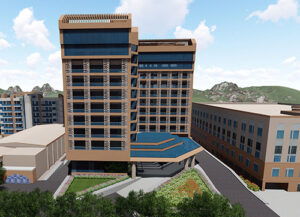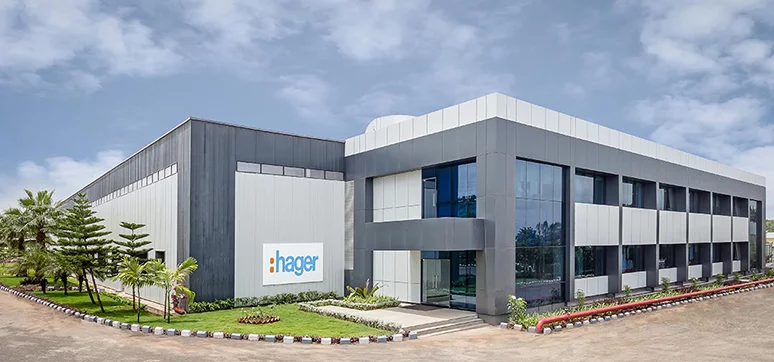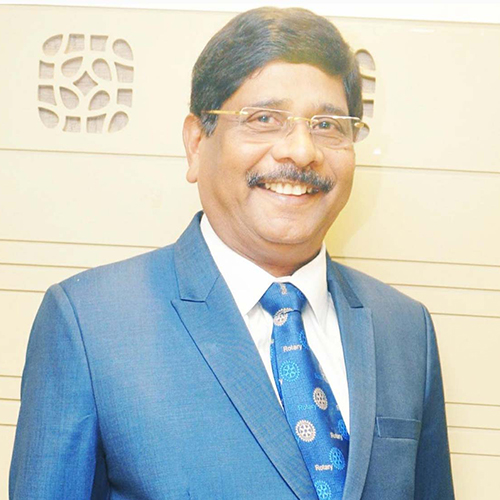What are the 4 key trends in exterior wall cladding?
Cladding, besides decorative appeal, is beneficial with its isolating characteristics of the soundproof and thermal insulation. While considering all aspects given above, glass façades, ACP cladding, metal claddings and GFRC cladding panels, etc. are the most trending cladding material /solutions which are now improvised and used.
How would clever use of cladding technologies and materials regulate daylight and ventilation as well as provide privacy?
As an architect it’s our responsibility to make the building more climate responsive and hence the façade to be intelligent and adaptive. Such façades include rear ventilated, double skin, kinetic, etc. which show better performance index in varied aspects.

According to you what is the most preferred and dominant cladding material in this industry at present and why?
Glass has been the foremost choice across the country, although bemoaned by many architects. But the understanding that glass as a complete façade solution may not be ideal, has paved the way for other trends. On the other hand, the ACP cladding sheet is also the most preferred material along with glass. The availability of this material in its economic manner makes it easily accessible and also weather proof, stain resistant and highly durable. The panels retain their colour, shape and size even after exposure to sunlight and weather changes making it ideal for all seasons.
What is the trendiest cladding material which can be called as the material for the future façades?
Glass Fibre Reinforced Concrete (GFRC) is an ideal material for building envelopes because it is durable, it can resist fire, and the environmental impact is low compared to other materials because the base materials used in the production of GFRC are widely available throughout the world. It is prefabricated, reducing the construction cost and time, noncorrosive, lightweight and complex shapes can be worked out well.
Now, pneumatic façade technology has come into the industry with the interesting concept of flexible adjusting skins operated by soft robotics, one of the best examples of adaptive and responsive cladding.
What do you mean by intelligent & responsive cladding?
 CEPT Library, Ahmedabad (designed by RMA Architects)
CEPT Library, Ahmedabad (designed by RMA Architects)
An intelligent and responsive building envelope adapts itself to its environment by means of perception, reasoning and action. This adaptability enables an intelligent building envelope to cope with new situations and solve problems that arise in its interaction with the environment. An intelligent façade is not characterised primarily by how much it is driven by technology, but instead by the interaction between the façade, the buildings, services and the environment.
Please brief on some of the smartest cladding technologies & sustainable buildings
More and more building façades offer particular aesthetic geometries, breaking the convention of a flat-glass box structure, and buildings with complex curves and surface treatments are achieving artistic forms. There is also an increased focus on sustainability. This means façades need to be designed to reduce interior energy costs by using sunshades and low emissivity glass that allows natural lighting in without loss of thermal energy. There is an increased application of passive ventilation like employing double-skinned façades and other techniques, improving user experience without compromising on energy costs.
Library of CEPT building designed by RMA Architects is best example of smart cladding. Complete with an operating manual for students, the building’s modulated, louvered façade can be manually adjusted to allow less light or more ventilation in response to Ahmedabad’s severely hot and dry climate.
Tell us about the testing of cladding – the norms and standards to be followed?
 An office building for S-Forms
An office building for S-Forms
There are some common testing standards used in carrying out off-site performance test, which affects the structural performance, air-tightness and water-tightness before any mass production and subsequent installation on site which include: air infiltration test, water penetration test, and structural load test. Few of the additional tests include: the dynamic water penetration test, the seismic test, and the thermal cyclic test.
How to choose fire-safe cladding material?
Developments in material technology, changing design tastes, cost factors and specialisation of production have resulted in a situation where external walls are made up of many different components, manufactured and installed by multiple different parties. Modern construction products are highly dependent on organic materials derived from oil.
Private and social landlords, building owners and other property stakeholders, have placed a renewed emphasis on fire safety, particularly in respect to highrise buildings, to ensure residents feel safe and are safe. Over the past years, this has resulted in an increase in concerns about the fire safety ratings of different cladding systems. A modern nonload- bearing façade system has three main sections: the external cladding, thermal insulation and the backing wall.
All three parts may promote fire spread, and even combinations that have been demonstrated in tests to be safe might be problematic depending on the kind of materials used and their extent, arrangement and installation. To identify the products in the façade and exterior cladding to be fire proof, the product should have valid certifications of lab tests conducted with respect to fire norms.
Please brief on standards & norms for safe cladding by ECBC and BEE?
 Kurduwadi Railway station
Kurduwadi Railway station
Energy Conservation Building Code (ECBC) was developed by the Bureau of Energy Efficiency (BEE) which sets minimum energy performance standards of the various components of the building, while taking into the account the climatic zone in which it is located. The code is applicable to large commercial buildings having a connected load of 100 KW and above or contract demand 120 kVA and above and covers the following building systems:
- Building envelope
- Lighting
- Heating ventilation and airconditioners
- Service water heating
- Electric power and distributions
The code provides for energy efficient design for commercial building such that it reduces the use of energy without affecting the building function, comfort, health or productivity of the occupants and with appropriate regard for economic considerations. The code eliminates building design practices that lead to unnecessarily high building energy use and associated costs.
While the code has been developed at the central level, the state governments have the flexibility to modify ECBC to suit local or regional needs and notify them in its enforcement. A minimum energy performance standard for building envelopes is an integral part of ECBC. Coefficient of performance for Solar Heat Gain Coefficient (SHGC), U-values, Visible Light Transmittance (VLT) and air leakage for windows and skylights have been prescribed in the code for the various climatic zones of the country. It is important to note that the ECBC is a designed standard and does not prescribe any technology or product.
Please throw some light on future cladding designs and materials for exterior claddings
Future façade can be defined as fully responsive parametric façade that are non-static, but kinetic addressing varied issues including sustainability, power generation, vertical farming and are informative and transformational.














